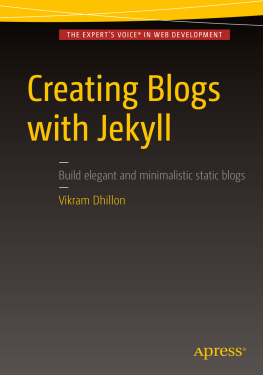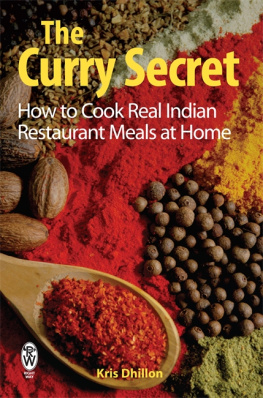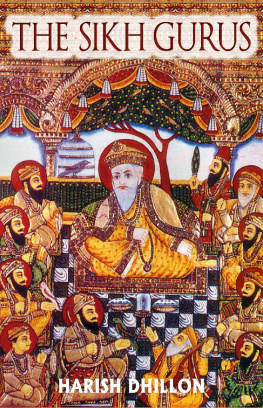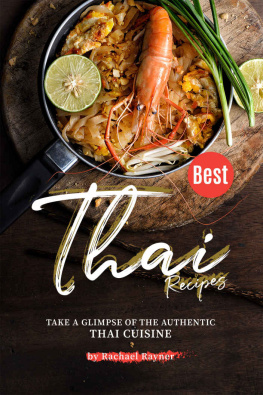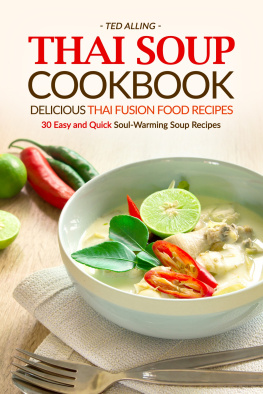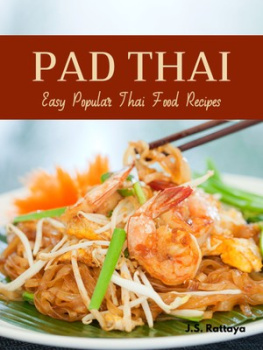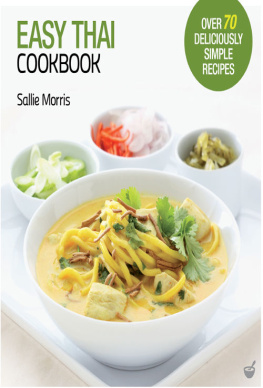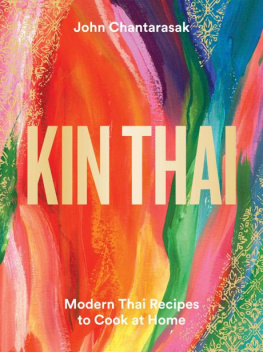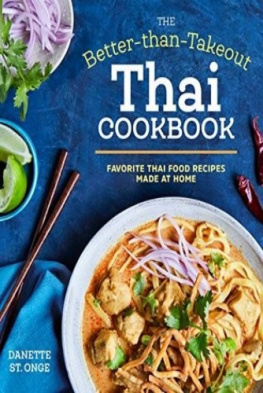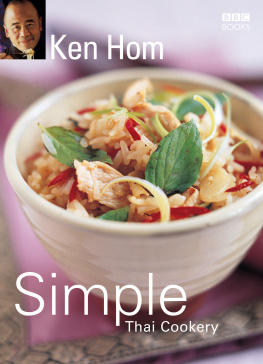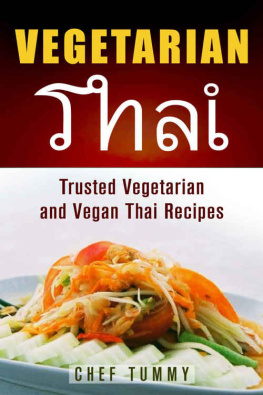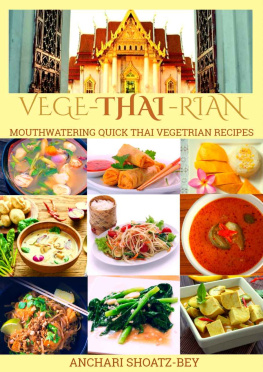THAI COOKERY SECRETS
How to cook delicious curries
and pad thai
Also in Right Way
The Curry Secret*
The New Curry Secret*
An Indian Housewifes Recipe Book
Chinese Cookery Secrets
Easy Jams, Chutneys and Preserves
* by the same author
www.constablerobinson.com/rightway
THAI
COOKERY
SECRETS
HOW TO COOK DELICIOUS
CURRIES AND PAD THAI

Kris Dhillon


Constable & Robinson Ltd
3 The Lanchesters
162 Fulham Palace Road
London W6 9ER
www.constablerobinson.com
Published by Right Way, an imprint of Constable & Robinson, 2010
Copyright Kris Dhillon 2010
The right of Kris Dhillon to be identified as the author of this work has been asserted by her in accordance with the Copyright, Designs & Patents Act 1988.
All rights reserved. This book is sold subject to the condition that it shall not, by way of trade or otherwise, be lent, re-sold, hired out or otherwise circulated in any form of binding or cover other than that in which it is published and without a similar condition including this condition being imposed on the subsequent purchaser.
A copy of the British Library Cataloguing in Publication Data is available from the British Library
ISBN: 978-0-7160-2227-5
Printed and bound in the EU
1 3 5 7 9 10 8 6 4 2
CONTENTS
INTRODUCTION
Before the publication of The Curry Secret almost 20 years ago, the Indian restaurant curry was an enigma. An elusive and moreish flavour that almost everyone loved but few outside of the closed restaurant community knew how to produce. Indian restaurant cooking had become shrouded in mystique and secrecy and it was the exploration and de-mystification of those cooking processes that made The Curry Secret a bestseller.
It is not so with Thai restaurant cuisine where the converse is true.
Thai restaurants in the western world barely capture the true essence of Thai food. The fresh, fragrant and intoxicating flavours of good Thai food are amazing taste sensations rarely replicated by the majority of Thai restaurants. Cooking fabulous Thai food need not be difficult, but it requires a commitment to really fresh, flavoursome ingredients, correctly combined and quickly cooked to retain all their wonderful colour, aroma and flavour. Too many Thai chefs in the west compromise with the quality and freshness of the ingredients or the way they are cooked so that much of those delicious, satisfying flavours typical of real Thai cuisine are lost.
To experience the best of Thai food, you have to cook it like they do in Thailand.
My interest in Thai food began almost a quarter of a century ago when I fell in love with the delicious, complex spicy flavours of Tom Yum Soup, skewered Sate Chicken and Thai Red Curry served in a well frequented Thai restaurant in Birmingham, England. Like most non-Thais, however, I found that many of the ingredients used to produce these flavours were a bit of a mystery and very difficult to source. Since then several trips to Bangkoks vibrant food scene have served to increase my understanding of and cement my relationship with Thai cuisine and, as Asian cuisines have become increasingly popular all over the world, many of the uniquely Thai ingredients are now much easier to find. Thai food still remains an enigma to many people though, and this book is written from the understanding of a non-Thai for non-Thais wishing to cook this wonderful food in their own kitchens.
It quickly becomes obvious to anyone visiting Thailand that food is central to the fabric of Thai society. For Thais, food is not just for eating. It is a reason for people to get together with friends, family and community in celebration and joy. In Thai culture, as in my own Indian culture, food is used for religious offerings and services, and leftovers are never wasted. To throw food away is, in Thailand, a sin punishable by the God of rice with bad luck or famine.
Thai cuisine is colourful, fragrant, healthy and delicious and, to top it all, dishes are always beautifully presented. The concept of intricate and artistic presentation of food has been around for centuries in Thailand. It was first developed in the royal palaces where royal chefs had to make meals highly attractive as well as superbly delicious. Beautiful presentation has become an important aspect of Thai cuisine. Serving platters are often decorated with all manner of exquisitely carved fruits and vegetables, whilst palace-style stir-fries usually incorporate elegantly carved vegetables within the dish itself.
Traditional Thai cuisine consists of various types of meat and seafood combined with locally produced vegetables, herbs and spices always served with rice. Around the fourteenth century the Chinese introduced noodles and wok cooking to Thailand and, later, influences from neighbours such as Vietnam, Cambodia, Burma, Indonesia, Malaysia and others resulted in the modern-day complex flavours of Thai food.
India has also played a significant role in the evolution of Thai cuisine, but the majority of Thai curries remain quite different from Indian curries. Although some Indian spices are used in a minority of Thai dishes, Thai food has developed its unique flavour due to the use of local ingredients such as galangal (similar to ginger), lemongrass, kaffir lime and Thai holy basil.
Pad Thai, meaning Thai style frying, is a dish of stir-fried noodles with several other ingredients including egg, peanuts, shallots, bean sprouts, tofu and meat or seafood flavoured with lime or tamarind. Although the dish has been eaten in various forms throughout Thailand for centuries, Pad Thai as we know it today was purported to have been developed in Bangkok to serve busy office workers with a quick, nutritious and tasty meal during their lunch breaks. Whilst the best Pad Thai is still to be found at the food stalls of Bangkoks food markets, it is now one of the most popular Thai dishes in restaurants around the world, although this version tends to be oilier and heavier than the lighter Pad Thai found on the streets of Thailand.
Whilst the spectacularly fresh and complex flavours of Thai food cooked in Thailand may be near impossible to replicate perfectly elsewhere, there need not be any mystery about cooking delicious Thai food anywhere in the world. It is quite simple once you come to know the basic principles of Thai flavours and this book will show you how to get those wonderful flavours from locally produced and imported ingredients. It will also give you some nifty cooking techniques and lots of helpful tips to help make cooking great Thai food a breeze.
1
ABOUT THAI CURRIES
Curry in some form or another is popular throughout Asia and the Middle East. Thought to have its origins in India and Pakistan, curry was introduced to south-east Asia by Indian immigrants several centuries ago, where over time it underwent a period of evolution, changing and developing some unique characteristics with the inclusion of local ingredients and cooking styles.
Thai v Indian Curry
The typical Thai curry (gaeng) is quite different from Indian curry. The Thai curry is generally a speedily cooked more soup-like dish made with coconut milk or water with a complex and aromatic base of fresh curry paste, compared to its Indian counterpart which is often slow cooked with a thicker sauce made with a base of onion, ginger and dried spice blends. Also, Thai cooks use more fresh herbs (such as lemongrass, kaffir lime and basil) and rarely use the dried herbs and spices favoured by Indian cooks. On the whole there are very few Thai curries that resemble Indian curries. A couple of exceptions are the Massaman (Thai Muslim) and Panang curry two Thai curries based predominantly on dried herbs and warm Indian style spices.


